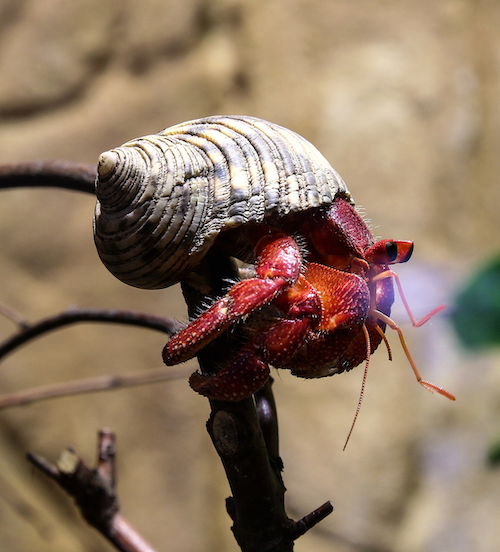| Crustaeceans and Marine Arthropods |
| Horsehoe Crab |
| Christmas Island Crab |
| Coconut Crab |
| Hermit Crab |
| Fiddler Crab |
| Alaskan King Crab |
| American Lobster |
| Rusty Crayfish |
Image Credit: https://pixabay.com/users/garten-gg-201217/ |
Along the sandy shores and coastal habitats of the world, a small and captivating creature can be found, carrying its home on its back—the hermit crab. Often spotted scurrying along the beach with a borrowed shell for protection, hermit crabs are unique and resourceful crustaceans.
Adaptation and Innovation: The Shell-Seeking Hermit
Unlike their close relatives, true crabs, hermit crabs lack a hard, calcified abdomen to protect their vulnerable hind parts. To compensate for this, hermit crabs have developed a fascinating behavior—they appropriate abandoned gastropod shells to use as portable shelters. As the hermit crab grows, it upgrades to larger shells, leaving behind the smaller ones for smaller individuals or those who may have lost their homes.
Diverse Habitats: From Tropical Beaches to Ocean Depths
Hermit crabs are incredibly adaptable, with species found in a variety of environments, from shallow tropical waters to deep-sea floors. Most commonly associated with coastal areas, they can be found on sandy shores, rocky intertidal zones, and even in mangrove forests. Their ability to move between land and water is a testament to their versatility and resourcefulness.
Dietary Habits: Omnivorous Scavengers of the Shore
Hermit crabs are opportunistic feeders, scavenging for a wide range of food items. Their diet may include algae, small invertebrates, detritus, and even carrion. The scavenging lifestyle of hermit crabs plays a crucial role in maintaining the balance of their ecosystems by contributing to the decomposition of organic matter.
Molting Process: Shedding the Old for the New
Like other crustaceans, hermit crabs undergo a molting process to grow. During molting, the hermit crab sheds its exoskeleton, revealing a soft, vulnerable body underneath. This process is risky, as the hermit crab is temporarily defenseless until its new exoskeleton hardens. To protect themselves during molting, hermit crabs often retreat into their shells or find hidden locations in the sand.
Social Behavior: The Unexpected Sociability of Hermit Crabs
While generally considered solitary creatures, hermit crabs exhibit social behaviors, especially during periods of mating. Male hermit crabs may form small groups, competing for the attention of females during courtship rituals. These rituals involve elaborate displays and interactions to ensure successful mating.
Hermit Crab Species: A Diverse Family of Crustaceans
The hermit crab family, or Paguroidea, consists of a diverse array of species. From the iconic Caribbean hermit crab (Coenobita clypeatus) to the colorful and intricately patterned Dardanus species, each hermit crab species showcases unique characteristics adapted to its specific habitat.
Conservation Considerations: Protecting Coastal Biodiversity
While hermit crabs are not currently considered threatened or endangered, their habitats face increasing pressures from human activities, pollution, and habitat destruction. Coastal ecosystems, where hermit crabs play a vital role, require conservation efforts to ensure the continued well-being of these fascinating crustaceans and the diverse array of species that share their environments.
Pets
Hermit crabs, often chosen as exotic and fascinating pets, make for unique companions with their charming antics and captivating behaviors. These small crustaceans, typically kept in aquariums, are known for their habit of adopting and carrying seashells as mobile homes. Hermit crabs thrive in a warm and humid environment, requiring proper care to ensure their well-being. Owners often provide a variety of shells for them to choose from as they grow, simulating their natural behavior of upgrading their homes. Offering a diet of fresh fruits, vegetables, and high-calcium foods contributes to their overall health. Despite their small size, hermit crabs are surprisingly interactive and social, especially when housed in groups. Caring for hermit crabs as pets involves creating a suitable habitat, maintaining proper humidity levels, and providing opportunities for exploration and climbing.
